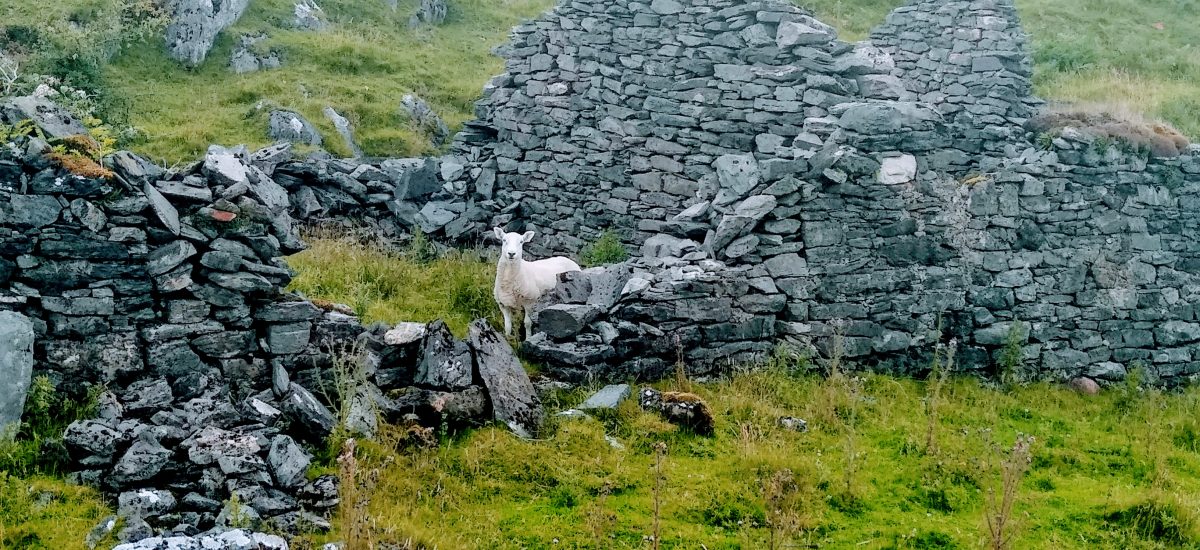24 August 2020
The sea is silky, shadowed and inviting, the sky dappled with non-threatening clouds. Alas, Storm Francis is battering its way north. It’s early to name storms.
Biked to the museum yesterday on bike-busy roads. Plenty of wandering cyclists plus a large family with a dog occupying the entire road. They looked surprised when I rang my bell. I wanted to see the Heritage Museum’s 2020 special exhibition which opened in July, after lockdown. Sadly fewer people will see it. Sadly because this is about a crucial time in the island’s story.

As told in Robert Hay’s book, How an Island Lost its People: Improvement, clearance and resettlement on Lismore 1830-1924.
Both this book and the exhibition speak volubly of a time when many Liosaich left because they could not support themselves or because they were ‘cleared’. Surely that is a euphemism for a horror. For those who stayed life often became an unrelenting grind, a daily struggle to adapt or fail to adapt. The repercussions of these times are still with us. Thank goodness not as it was then; far from it, their lives are unimaginable. But sustainability matters today as it did then and, when the 1,831 Liosaich who lived here in the 1800s began to suffer increasing hardships, the population decline began. By 1850 only 600 remained. Today there are fewer than 200.
It was a heartbreaking time. To hear the voices of Liosaich giving evidence to the Napier Commission is to hear their mistreatment by absent landowners, the naked disregard for their well-being, the steady erosion of the lives they had known. It’s worth opening the images above to hear for yourself. They came from everywhere from Frackersaig to Port Ramsay.
The Napier Commission was in fact the Royal Commission of Inquiry into the Condition of Crofters and Cottars in the Highlands and Islands. It was set up in 1883 as a response to crofters’ demands for desperately needed Land Law Reform. It was led by Francis Napier, a diplomat and the 10th Lord Napier. Prime Minister William Gladstone hoped the commission would end the unrest.
In the exhibition these words from Liosaich were hung about the room while the family trees of some who stayed, were on the wall: the MacGregors, MacColls, Blacks and Carmichaels. Names we all know and descendants we know and have known. In addition, information about trades such as boat building, with the relevant tools, were hung with lime quarrying tools, both big trades and industries in their day. Trades that made staying possible.

Dòmhnall MacIlleDhuibh says in his book that, ‘this island in the first two or three decades of the 19th century could boast a diversity of skills and trades … there were 42 people engaged in occupations other than agriculture’. One of these was boatbuilding. You can read about this on the Comann Eachdraidh website.
On a different note, last night’s 2007 Prom on BBC Four was the Simón Bolívar Youth Orchestra with Gustavo Dudamel conducting Shostakovich’s Tenth symphony with no score. That’s amazing. The playing was so precise, exciting, spirited and romantic at times that it was hard to imagine I had ever heard it before. Well I hadn’t as this fresh bunch played it.
But … I am telling you about this knowing you may or may not care about the music … because this orchestra has grown from the Venezuelan education programme El Sistema where impoverished children are offered instruments and musical training from the age of three. It was the brainchild of José Antonio Abreu, (1939-2018), who was determined to transform children’s lives through music. By 2015 El Sistema had more than 400 music centres and 700,000 young musicians.
And it exists here. Sistema Scotland’s mission is also to transform lives through music. They work with 2,800 children and young people across four Big Noise (love the name) orchestral programmes: Raploch in Stirling, Govanhill in Glasgow, Torry in Aberdeen, and Douglas in Dundee. Big Noise changes lives. I’m a fan. You can donate to this positive social movement: Big Noise. Reading about them made me wish I were a child in Scotland right now.
In Lismore youngsters have been making a big noise for quite a time, learning instruments at home and at school and being well-used to performing in public whether they like it or not. But I must save Lismore and music for another day. It is too big a subject.

























